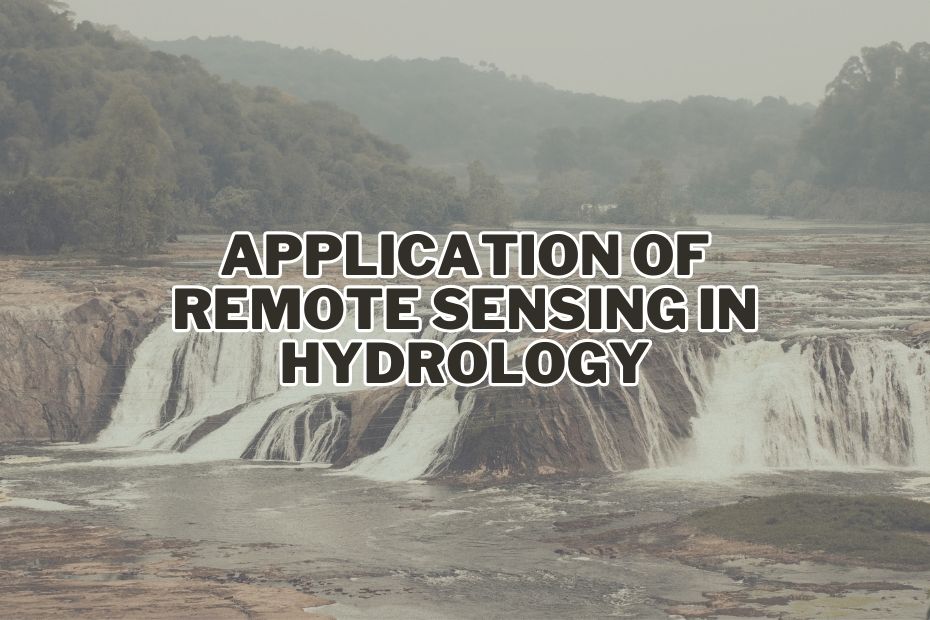Remote sensing technology has revolutionized the field of hydrology, offering valuable insights and data that were previously challenging to obtain. By utilizing various sensors and imaging techniques, remote sensing has become an essential tool for studying water resources and managing water-related issues. In this article, we will explore crucial application of remote sensing in hydrology, shedding light on how it contributes to a better understanding of our water systems.
Remote Sensing enables the monitoring of water bodies, precipitation, and snow cover, providing valuable insights into hydrological processes. With its ability to detect changes in water levels and identify potential flood risks, remote sensing enhances water resource management and flood forecasting.
Application of Remote Sensing In Hydrology
Welcome to the fascinating world of remote sensing and its pivotal role in hydrology. It’s a beautiful blend of technology and nature. But how does it work? Simply put, we capture and analyze images of the Earth’s surface to gather data about our water resources. Now let’s dive deep into the incredible application of remote sensing in hydrology.
1. Flood Monitoring and Management
Floods pose significant threats to communities, economies, and ecosystems worldwide. Remote sensing plays a pivotal role in flood monitoring and management by providing timely and accurate data. Satellite imagery and synthetic aperture radar (SAR) help monitor flood extents and assess potential risks. By integrating remote sensing data with hydrological models, authorities can make informed decisions to mitigate flood impacts and implement effective disaster response strategies.
2. Drought Assessment
Droughts can have devastating consequences on agriculture, water supply, and ecosystems. Remote sensing enables the monitoring of soil moisture, vegetation health, and water levels in reservoirs, aiding in drought assessment. This valuable information assists policymakers in drought forecasting and the development of water conservation measures to alleviate the impact of prolonged dry periods.
3. Snow Cover Mapping
Snow cover mapping is crucial for water resource management, especially in regions where snowmelt significantly contributes to river flows. Remote sensing technologies like passive microwave radiometry and optical sensors help track snow accumulation and melting patterns. This data is vital for predicting water availability, managing reservoirs, and supporting hydroelectric power generation.
4. Groundwater Exploration
Accessing groundwater resources is essential for sustainable water supply, especially in arid regions. Remote sensing techniques, such as thermal infrared and electromagnetic surveys, aid in identifying potential groundwater locations. This information guides drilling efforts and ensures the responsible use of groundwater to meet various demands.
5. Sediment Load Monitoring
Excessive sediment in rivers and streams can lead to erosion, reduced water quality, and adverse effects on aquatic life. Remote sensing instruments, such as multi-spectral cameras and LiDAR (Light Detection and Ranging), enable the estimation of sediment loads in water bodies. Monitoring sediment dynamics helps in erosion control and sediment transport management.
6. Water Quality Assessment
Maintaining water quality is crucial for human health and the environment. Remote sensing facilitates water quality assessment by detecting pollutants, algae blooms, and changes in water clarity. Continuous monitoring using satellites and drones allows for prompt actions to safeguard water resources and aquatic ecosystems.
7. Irrigation Management
Efficient irrigation practices are vital for optimizing agricultural productivity while conserving water resources. Remote sensing technologies aid in assessing crop health, soil moisture, and irrigation efficiency. By providing real-time information, farmers can make informed decisions regarding irrigation scheduling and water allocation.
8. Estuary Dynamics
Estuaries are ecologically sensitive zones where rivers meet the sea. Understanding estuary dynamics is crucial for managing coastal resources and ecosystems. Remote sensing tools, such as hyperspectral imaging, enable the study of estuarine water quality, tidal movements, and habitat changes, contributing to effective conservation and sustainable development.
9. Hydrological Modelling
Hydrological models simulate the movement of water through the hydrological cycle, aiding in water resource planning and management. Remote sensing data, such as rainfall estimates and evapotranspiration rates, serve as critical inputs for these models, enhancing their accuracy and reliability.
10. Evapotranspiration Calculation
Evapotranspiration refers to the combined process of water evaporation from the Earth’s surface and transpiration from plants. Accurate evapotranspiration calculations are essential for assessing water availability and managing irrigation. Remote sensing, particularly thermal infrared imagery, provides valuable data for estimating evapotranspiration rates over large areas.
11. River and Streamflow Measurement
Monitoring river and streamflow is vital for flood forecasting, water allocation, and ecological assessments. Remote sensing technologies, such as radar altimetry and river gauging from spaceborne sensors, enable the continuous measurement of water levels in rivers and streams. This data helps in understanding hydrological patterns and planning water-related infrastructure.
12. Wetland Mapping and Conservation
Wetlands play a crucial role in flood regulation, water purification, and biodiversity conservation. Remote sensing techniques, including synthetic aperture radar and hyperspectral imaging, aid in wetland mapping and monitoring. Understanding wetland dynamics helps in conserving these ecologically sensitive habitats.
Conclusion
The application of remote sensing in hydrology are transformative. From predicting floods to conserving wetlands, it is shaping the future of water resource management. The applications we explored illuminate the enormous potential of this technology. Through remote sensing, we are not only solving today’s hydrological challenges but also preparing for those of the future.
FAQs: Application of Remote Sensing In Hydrology
How is remote sensing used in flood management?
Remote sensing helps in detecting and managing floods by providing real-time data on flood-prone areas.
Can remote sensing predict droughts?
Yes, remote sensing can anticipate and monitor droughts by tracking parameters like vegetation health and soil moisture levels.
What role does remote sensing play in hydrological modelling?
Remote sensing data enhance the accuracy of hydrological models, helping to predict future water availability and climate change impacts.
